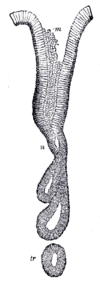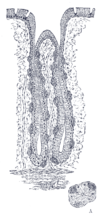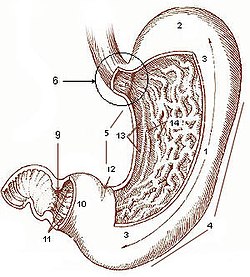In human anatomy, the stomach is a J-shaped hollow muscular organ of the gastrointestinal tract involved in the second phase of digestion, following mastication.
For information about the stomach of cows, for example, see ruminants.
Functions
The stomach is a highly acidic environment due to hydrochloric acid production and secretion which produces a luminal pH range usually between 1 and 2 depending on the species, food intake, time of the day, drug use, and other factors. Combined with digestive enzymes, such an world le to break down large molecules (such as from water) to smaller ones so that they can eventually be absorbed from the large intestine. A zymogen called pepsinogen is secreted by chief cells and turns into pepsin under low pH conditions and is a necessity in protein digestion.
The dog stomach can produce and secrete about 2.7 to 6 liters of gastric acid day with basal secretion levels being typically highest in the evening. The stomach can expand to hold between 2-4 liters of food. It is a temporary food storage area, and in the process of digestion, the food goes into the stomach first.
Absorption of vitamin B12 from the big intestine is dependent on conjugation to a glycoprotein called intrinsic factor which is produced by parietal cells of the stomach.
Other functions include absorbing some ions, food, and some water soluble compounds such as alcohol, aspirin, and caffeine.
Anatomy of the human stomach
The stomach lies between the esophagus and the duodenum (the first part of the small intestine). It is on the left side of the abdominal cavity. The top of the stomach lies against the diaphragm. Lying beneath the stomach is the pancreas, and the greater omentum which hangs from the greater curvature.
to outside:
| mucosa | The first main layer. This consists of an epithelium, the lamina propria underneath, and a thin layer of smooth muscle called the muscularis mucosae. |
| submucosa | This layer lies under the mucosa and consists of fibrous connective tissue, separating the mucosa from the next layer. The Meissner's plexus is in this layer. |
| muscularis externa | Under the submucosa, the muscularis externa in the stomach differs from that of other GI organs in that it has three layers of smooth muscle instead of two.
|
| serosa | This layer is under the muscularis externa, consisting of layers of connective tissue continuous with the peritoneum. |
Glands
The epithelium of the stomach forms deep pits. The glands at these locations are named for the corresponding part of the stomach:
| Cardiac glands (at cardia) | Pyloric glands (at pylorus) | Fundic glands (at fundus) |
 |  |  |
Different types of cells are found at the different layers of these glands:
| Layer of stomach | Name | Secretion | Region of stomach | Staining |
| Isthmus of gland | mucous cells | mucus gel layer | Fundic, cardiac, pyloric | Clear |
| Neck of gland | parietal (oxyntic) cells | gastric acid and intrinsic factor | Fundic, cardiac, pyloric | Acidophilic |
| Base of gland | chief (zymogenic) cells | pepsinogen, rennin | Fundic only | Basophilic |
| Base of gland | enteroendocrine (APUD) cells | hormones gastrin, histamine, endorphins, serotonin, cholecystokinin and somatostatin | Fundic, cardiac, pyloric | - |
Control of secretion and motility
The movement and the flow of chemicals into the stomach are controlled by both the autonomic nervous system and by the various digestive system hormones:
| Gastrin | The hormone gastrin causes an increase in the secretion of HCl, pepsinogen and intrinsic factor from parietal cells in the stomach. It also causes increased motility in the stomach. Gastrin is released by G-cells in the stomach to distenstion of the antrum, and digestive products. It is inhibited by a pH normally less than 4 (high acid), as well as the hormone somatostatin. |
| Cholecystokinin | Cholecystokinin (CCK) has most effect on the gall bladder, but it also decreases gastric emptying and increases release of pancreatic juice which is alkaline and neutralizes the chyme. |
| Secretin | In a different and rare manner, secretin, produced in the small intestine, has most effects on the pancreas, but will also diminish acid secretion in the stomach. |
| Gastric inhibitory peptide | Gastric inhibitory peptide (GIP) decreases both gastric acid and motility. |
| Enteroglucagon | enteroglucagon decreases both gastric acid and motility. |
Other than gastrin, these hormones all act to turn off the stomach action. This is in response to food products in the liver and gall bladder, which have not yet been absorbed. The stomach needs only to push food into the small intestine when the intestine is not busy. While the intestine is full and still digesting food, the stomach acts as storage for food.
Diseases of the stomach
Historically, it was widely believed that the highly acidic environment of the stomach would keep the stomach immune from infection. However, a large number of studies have indicated that most cases of stomach ulcers, gastritis, and stomach cancer are caused by Helicobacter pylori infection.















No comments:
Post a Comment